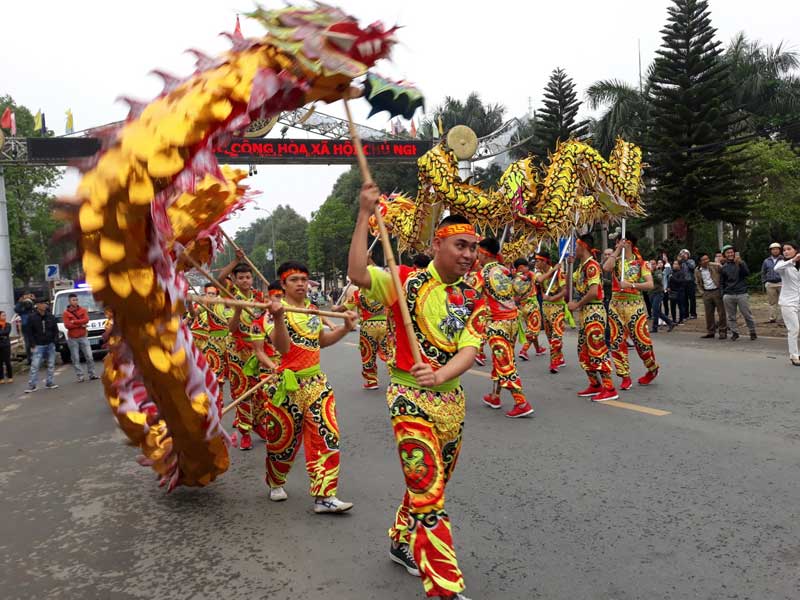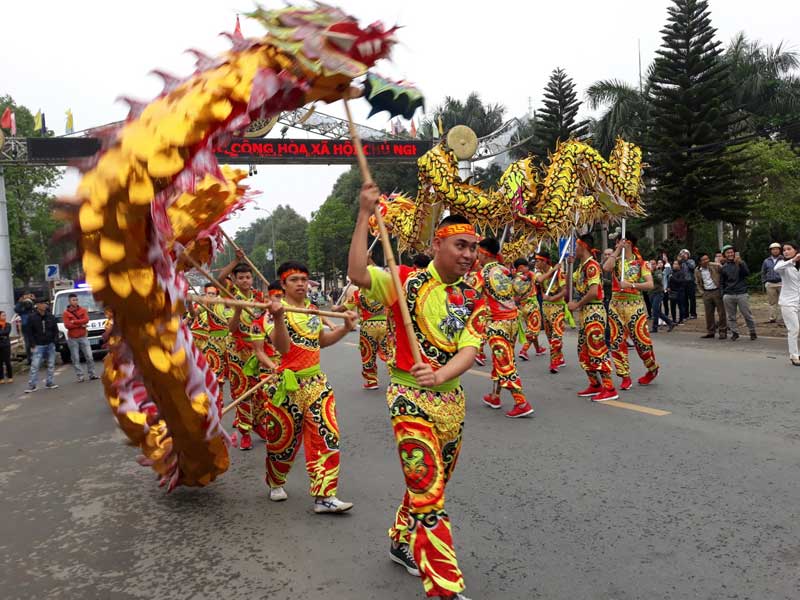
(HBO) - Cao Phong – the land of Muong Thang is rich in the traditional cultural identity, retaining many intangible cultural features imbued with the national identity. It is a part of Hoa Binh Culture, where there are many beautiful landscapes, cultural and historical relics associated with the struggle of the nation, and it has become an attractive destination attracting domestic and international tourists.

The festival of Bong Lai temple in Cao
Phong town is organized with many activities, attracting a large number of
tourists.
Cao
Phong is a locality with the potential to develop various types of tourism
including community tourism, garden tourism, cave exploration, visiting historical
and cultural sites. The most outstanding is the cultural and spiritual tourism
with many attractions such as Chua Thac Bo Temple (Thung Nai Commune), Thuong
Bong Lai Temple (Cao Phong Town), Khanh Pagoda (Yen Thuong Commune), Quen Ang
Pagoda (Hop Phong commune), a tribute to the hero, Cu Chinh Lan (Binh Thanh
commune) ...
With
the potentials and the advantages in tourism and beautiful natural landscapes,
many landscapes containing legends have gone down in the history. In recent
years, the district has issued decisions on tourism development, building a
master plan for tourism development in the province, gradually promoting
investment in infrastructure construction, connecting tours and the tourism
attractions in the district. In particular, it is necessary to mention the
investment in renovating, embellishing and building temples and pagodas in the
direction of restoring the original state. They have been investing in
developing eco-tourism and cave tourism in combination with the spiritual cultural
tourism, creating a highlight to attract tourists from inside and outside the
district coming to Cao Phong.
Currently,
the district is implementing the project of Preserving and promoting the value
of the cultural heritage of Mo Muong in Hoa Binh in the period of 2019 - 2025
and the following years. Accordingly, the district has also been implementing a
plan to build a space to preserve the cultural heritage of Mo Muong in
association with tourism services in Hop Phong commune, which re-expresses the
unique culture of four ancient Muong regions of the province (Muong Thang,
Muong Bi, Muong Vang, Muong Dong) and the cultural exchange area of Viet Muong,
Coi mountain peak...
In the whole district there have been 29 shamen often
performing Mo rituals in communes and towns. The scope and scale of Mo beliefs
are reflected in the rituals in the life of Muong people in Cao Phong. Mo songs
are of great educational significance to Muong ethnic community. They have the
content of advising people to avoid doing evils, conveying the spirit of
solidarity of the family, the clan, the community and the ethnic group.
In the first 9 months of 2024, Hoa Binh province continues to implement the expanded tourism development cooperation program plan of 8 Northwest provinces with Ho Chi Minh City; deploying digital transformation content in tourism and developing a smart tourism province. Hoa Binh province received about 3.6 million views, an increase of 7.9% over the same period. In which, international visitors are about 380 visitors, domestic visitors are estimated at 3 million 220 visitors.
Spanning thousands of hectares and winding gracefully along mountain slopes, hillsides, and riverbanks, the terraced rice fields of Lac Son District present a stunning and captivating beauty. This region, renowned for its remarkable terraced landscapes, is also the centre of Hoa Binh Culture known for numerous archaeological sites.
The life of Mong people in Hang Kia and Pa Co communes of Mai Chau district has improved much thanks to tourism development.
The man-made Hoa Binh Lake, with a water surface area of approximately 9,000 hectares and a capacity of 9.45 billion cubic meters, stretches over 200 kilometers from Hoa Binh to Son La provinces. With the goal of developing into a national tourism area, the Hoa Binh Lake tourism area is expected to not only become the largest tourism centre in the province but also one of the 12 key tourist destinations in the northern midland and mountainous region of Vietnam.
Da Bia hamlet, now Duc Phong, in Tien Phong commune, Da Bac district, was once almost isolated from the outside as the only way to the hamlet was to get a boat ride across the Hoa Binh reservoir. However, as its tourism potential has been unleashed, the hamlet has established itself as one of the most attractive destinations on the tourism map. It has even received the ASEAN Community-Based Tourism Awards in 2019.
In the first 9 months of 2024, Mai Chau district, Hoa Binh province welcomed over 684 thousand visitors to visit and relax. In which, over 516 thousand domestic visitors and more than 168 thousand international visitors. Total revenue from tourism is estimated at over 821 billion VND.



